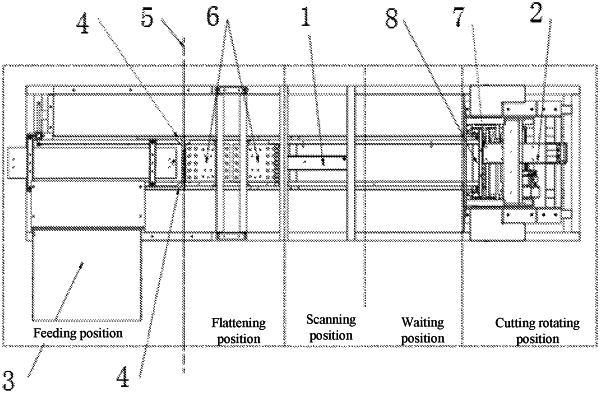| CPC A22C 17/0086 (2013.01) [A22C 29/00 (2013.01)] | 9 Claims |

|
1. A calculation method for intelligent cutting squid white slices, the calculation method being implemented on a calculation device; the calculation device having at least one processor and at least one storage medium including an instruction set used for intelligent cutting the squid white slices, the calculation method comprising:
reading a laser point cloud data of a three-dimensional (3D) topography of the squid white slices;
optimizing the laser point cloud data;
extracting an effective area of the squid white slices;
determining a cutting zero point;
determining a cutting process area; and
determining optimization of a cutting point position and a cutting angle; wherein the determining optimization of a cutting point position and a cutting angle comprises:
(a) setting a cutting point position of a first cut at an edge of the cutting process area, and setting a cutting angle as a at the same time;
(b) traversing backward at the cutting angle α to find a cutting point position d1 of a second cut according to quality requirements of squid block products, calculating an intersection p1 of the second cut and an upper surface, and calculating a reference value L of a diagonal length of a cut squid block;
(c) when calculating a cutting point position of a third cut, first obtaining, according to the reference value L of the diagonal length, a cutting position p2 from an upper surface of the squid and a cutting point position d2 from a lower surface of the squid; then determining whether a slice volume between a current cutting position and a previous cutting position satisfies a quality requirement; in response to a determination that the slice volume between the current cutting position and the previous cutting position satisfies the quality requirement, performing cutting directly; in response to a determination that the slice volume between the current cutting position and the previous cutting position does not satisfy the quality requirement, adjusting the cutting angle α; after several adjustments, the quality requirement being still unsatisfied, restoring the cutting angle to α, and translating the cutting position according to a quality difference;
(d) calculating, according to a same method as calculating the cutting point position and the cutting angle of the third cut, a cutting point position and a cutting angle of a rest cutting process area; and
(e) sending a calculated optimal solution of the cutting point position and the cutting angle of the squid white slices to a control system for cutting until an end of the process.
|